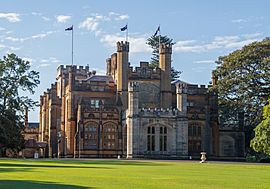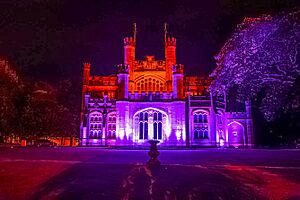Government House, Sydney facts for kids
Quick facts for kids Government House |
|
|---|---|

Main façade of Government House
|
|
| General information | |
| Status | Complete |
| Type | Vice-regal residence |
| Architectural style | Gothic revival style |
| Location | Royal Botanic Gardens, Conservatorium Road, Bennelong Point, Sydney, New South Wales |
| Country | Australia |
| Coordinates | 33°51′36″S 151°12′54″E / 33.859919°S 151.215008°E |
| Current tenants | Governor of New South Wales (as the vice-regal representative of the King of Australia) |
| Construction started | 1837 |
| Completed | 1847 |
| Owner | The King in Right of New South Wales (via the Department of Premier and Cabinet) |
| Design and construction | |
| Architect |
|
| Architecture firm | Colonial Architect of New South Wales |
| Official name | Government House, Movable Heritage Collection and Gardens |
| Type | state heritage (complex / group) |
| Criteria | a., b., c., d., e., f. |
| Designated | 13 December 2011 |
| Reference no. | 1872 |
| Type | Government House |
| Category | Government and Administration |
| Builders | Various tradesmen supervised by Mortimer Lewis |
Government House is a special historic building in Sydney, New South Wales, Australia. It is the official home and workplace of the Governor of New South Wales. The house is located next to the Royal Botanic Garden, Sydney and looks out over Sydney Harbour.
This grand building was constructed between 1837 and 1843. It has been the main residence for the Governor since 1845, starting with Sir George Gipps. There were two short periods when it was used for other purposes. From 1901 to 1914, it was the home of the Governor-General of Australia. Then, from 1996 to 2011, the Governor did not live there.
Government House was returned as the Governor's residence in October 2011. It is built in a style called Gothic revival style, which looks like old castles. The building is officially listed on the New South Wales State Heritage Register because of its historical importance.
Contents
History of Government House
Building the Governor's Home
In 1835, the British Government decided that Sydney needed a new Government House. A royal architect named Edward Blore drew up the plans. Construction began in 1837. Mortimer Lewis, the colonial architect, and Colonel Barney of the Royal Engineers oversaw the building work. Materials like stone, cedar wood, and marble came from different parts of New South Wales.
Even though it wasn't fully finished, a big party was held in the new building in 1843 to celebrate Queen Victoria's birthday. The first Governor to live there, George Gipps, moved in during 1845.
Early Years (1845–1901)
Government House sits on five hectares (twelve acres) of land with beautiful gardens overlooking Farm Cove, New South Wales. It was designed to look like a romantic Gothic castle, with towers and decorative details. Inside, it was decorated with paintings and the coats of arms of past Governors.
Over the years, some parts were added. A front entrance porch was built in 1873, and an eastern verandah was added in 1879. The ballroom and the Governor's study were made larger in 1900–1901. From 1845 until 1901, the building served as the Governor's home, office, and a place for official events.
Used by the Governor-General (1901–1914)
When Australia became a federation in 1901, a new role was created: the Governor-General. Government House was then used as the home for this new official. During this time, the Governors of New South Wales lived in a different house called Cranbrook.
In 1913, it was decided that the Governor-General would have a new residence at Admiralty House, Kirribilli.
Back to the Governor (1914–1996)
From 1914 until 1996, Government House once again served as the home, office, and official reception area for the Governor of New South Wales.
A Time Without a Resident Governor (1996–2011)
In 1996, the Premier of New South Wales at the time, Bob Carr, decided that the Governor would no longer live at Government House. The Governor's office was moved to another building nearby. Premier Carr wanted the Governor's role to be "less associated with pomp and ceremony."
This decision caused some debate. It was thought that moving the Governor out would save money, but the Auditor-General of New South Wales later found that it actually cost more to maintain the building without someone living there. Public visits also decreased. Many people felt that the Governor should live in Government House.
Even without a resident Governor, Government House was still used for important state events. For example, it was a key meeting place for APEC Australia 2007 in September 2007, where leaders from 21 countries met.
The Governor Returns (2011–Present)

In October 2011, the Premier Barry O'Farrell announced that the Governor, Marie Bashir, would move back into Government House. He believed the Governor should live in the house it was built for.
Because the house had not been a residence for fifteen years, some renovations were needed. The Governor first moved into a smaller building next door called the chalet. The main house was refurbished, and the Governor moved in before Christmas that year. Since December 2013, the Office of the Governor has managed Government House.
Exploring Government House
The Beautiful Gardens
Much of the original 19th-century look of the grounds remains. The gardens include private areas and formal open spaces. Near the house, there is a giant Moreton Bay fig tree, planted soon after the house was finished. The formal gardens have beautiful flower displays, neat lawns, and interesting trees. They connect us to Sydney's early colonial history.
The garden still has a 19th-century feel, mixing different styles. Many changes to the garden were made by past Governors and their wives. For example, Governor Denison had a five-acre vegetable garden, and Lady Game created a popular "Spring Walk." Some parts of the garden look just as they did in the 1800s, while others are more modern.
Thousands of people visit the garden each year for public tours and special events. The garden is also important for the house's functions. The chef often uses honey from the Governor's bees, herbs, and flowers from the grounds for food served at events.
Western Terrace
This is the oldest part of the garden, created between 1836 and 1845 while the house was being built. It helped screen the house and provided a pleasant area. Many evergreen trees were planted here. The original sandstone walls and some gravel paths still exist.
Eastern Terrace
The design for the Eastern Terrace was created in 1869 and is still a main feature of the garden. From the house's covered walkway, you can see across paths lined with flowerbeds to Sydney Harbour. Through trees, you can spot Fort Denison and Mrs Macquarie's Chair. The Eastern Terrace has a central sandstone pond with its original stone fountain.
Palm Grove
North of the Eastern Terrace is the Palm Grove, started in the 1870s for the Countess of Belmore. Here you can find native and exotic palms, including the Kentia palm from Lord Howe Island.
Spring Walk
In the 1930s, Lady Game, the Governor's wife, created the Spring Walk. She added new varieties of camellias to the existing 19th-century ones. Some of these camellias are over 100 years old. The entrance stones to the Spring Walk are said to be convict-made blocks from the very first Government House in Sydney.
Special Plantings
To the west of the driveway, there is a large paperbark tree and a peppermint tree. These were planted by Queen Elizabeth II and Prince Philip, Duke of Edinburgh in 1954. Many trees in the garden were planted during special ceremonies. Among the roses on the Eastern Terrace, you can find the "Dame Marie Bashir Rose," named after a former Governor.
Other Buildings on the Grounds
- The Lodge: Built around 1846, this is one of two Gothic-style buildings that remain near Government House. It looks like a guardhouse at Windsor Castle in England.
- Gatehouse: Built around 1937, this brick gatehouse replaced an older wooden one.
- The Chalet: Built around 1890, this building has a different style from Government House, with Tudor Gothic features like half-timbered gables and brick chimneys.
Inside the House
Government House is a two-storey building with a Gothic Revival style. It has battlements, turrets, detailed interiors, and a covered entrance for carriages. An open walkway on the east side forms a verandah with Gothic arches and a balcony above. The ground floor has twelve rooms, and the first floor has thirteen bedrooms. It is built of stone with a slate roof and wooden floors. There are also many offices and living areas for staff.
Special Collection
Government House has a collection of important historical items, including furniture, paintings, ceramics, and garden ornaments. These items are very significant to the history of New South Wales and Australia. Many pieces have a documented history, showing they belonged to NSW Governors or the first Governors-General.
The collection includes one of the earliest official portraits commissioned in NSW, that of Governor Thomas Brisbane. There is also a large collection of colonial furniture, including many pieces by the famous craftsman Andrew Lenham from 1845 to 1860.
Why Government House is Important
Government House, built in the early 1840s, was the home of the monarch's representative and the center of power in the colony. It symbolized British authority in New South Wales. The house and its occupants were seen as very important in society for a long time.
It has been home to twenty-four Governors of New South Wales and their families, as well as the first five Governors-General. Many important guests have visited, from citizens receiving awards to members of the Royal family and other world leaders.
The house is considered the finest example of a castellated Gothic house in Australia. Its design and gardens reflected its English connections and inspired other buildings in Sydney. It is a grand collection of buildings, gardens, and contents with a rich history. Changes over 150 years show how tastes and social attitudes have changed.
Located in Governor Phillip's original domain, it connects us to the earliest days of the colony. It is also linked to the development of other important public places nearby, like the Conservatorium (which used to be its stables) and the Royal Botanic Gardens (which were once part of its grounds).
Government House in Sydney was one of the two original official residences chosen for the Governor-General after Australia became a federation in 1901. It served as the Governor-General's Sydney home until 1912.
It is a rare example of a large harbourside estate that is still mostly intact and continues its original purpose: a private residence, office, and official event venue. The garden is one of the oldest continuously maintained gardens in Australia.
The historical importance of Government House is also enhanced by its amazing collection of movable heritage. This collection includes furniture, paintings, and other items dating back to the 1820s. It shows 150 years of changing styles and tastes.
Government House, Sydney, was listed on the New South Wales State Heritage Register on December 13, 2011.
Images for kids
-
Garden features in the formal gardens on the eastern side of the house, with views across to Sydney Opera House.
-
Cranbrook, 1917.
See also
- First Government House, Sydney, residence of the Governor from 1788 to 1845
- Old Government House, Parramatta, the country retreat for the early Governors
- Government Houses of Australia
- Government Houses in the Commonwealth
- Government House Sydney 360° Virtual Tour








